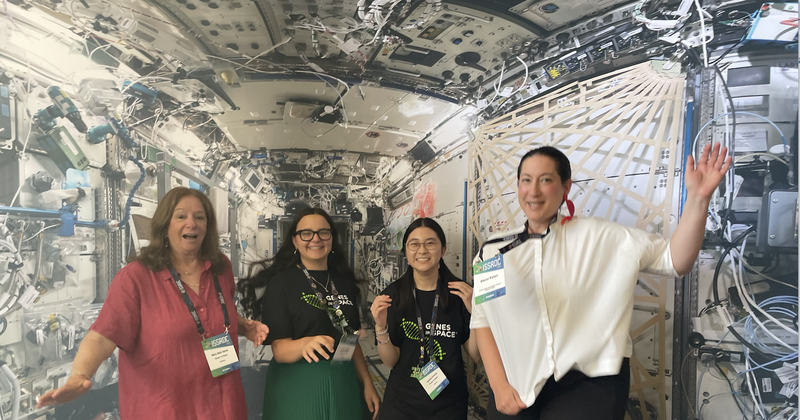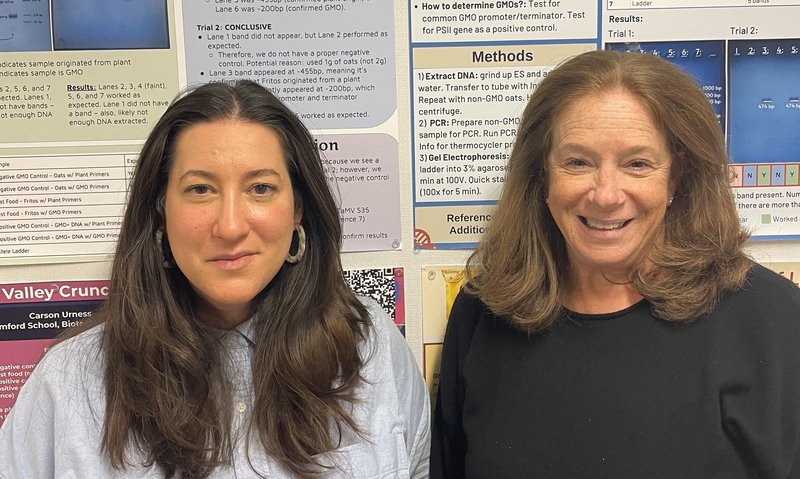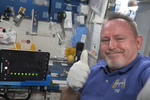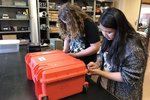GIS Spotlight: 2024 Winners' Teachers -Naomi Kohen and Mary Beth Spina

Dr. Mary Beth Spina (L), and Dr. Naomi Kohen (R) with their students, Genes in Space 2024 winners Julia Gross and Isabelle Chuang at the ISS Research and Development Conference this summer in Boston, MA
Since their achievement this summer, the winners of the 2024 Genes in Space contest, Julia Gross and Isabelle Chuang, have been working with space biology experts on the important task of developing their proposed experiment into a flight-ready payload bound for the International Space Station. We caught up with their teachers, Naomi Kohen and Mary Beth Spina from the Nightingale-Bamford School in New York City, to ask them how Genes in Space has impacted their students and how other classrooms may benefit from incorporating the competition into their curriculum.
How did you become aware of Genes in Space, and how long have you been using it in your classroom?
Kohen: I walked by the miniPCR bio booth at the vendor hall at the NSTA conference in San Francisco in 2019 and just happened to notice a sign about the competition. I was intrigued by the competition and was excited to learn more about it and how my students could participate. Teaching is a second career for me and so I love any opportunity to bring the world of research into my classrooms. The beauty of the Genes in Space competition is that students just need to bring their ideas - no physical resources are required to apply or progress through the competition.
How did you use Genes in Space in your existing curriculum?
Kohen: I teach a Biotechnology Laboratory course in which the students learn many of the techniques used by scientists to study biological macromolecules such as DNA and proteins. After students have gotten hands-on experience with PCR and ELISA, they have a homework assignment to fill out an application for the Genes in Space competition. We spend class time going over the competition requirements and resources (thank you for including so many on your website!) and looking at some cool past projects. After submitting the homework, students are given feedback on their proposals, and students who would like to formally submit their proposal to the competition are offered a small amount of extra credit for addressing the feedback and actually submitting an application.
I also teach a physics course and love bringing in the biological aspects of space travel when we learn about gravity. This is a great time to plug in the competition - students are often very intrigued by what might happen to their bodies or to plants on Mars (where acceleration due to gravity is lower than on Earth) or on Jupiter (where the acceleration due to gravity is higher than on Earth), or while experiencing weightlessness during orbit, which is what the astronauts on the ISS experience.
“The beauty of the Genes in Space competition is that students just need to bring their ideas - no physical resources are required to apply or progress through the competition.” - Dr. Naomi Kohen

Naomi Kohen (Left) and Mary Beth Spina (Right) at the Nightingale-Bamford School in Manhattan, NY
What did your students gain from participating in Genes in Space?
Kohen: So much! It gives them the chance to think creatively about a pressing problem. They are not just studying what we already know in science, but proposing experiments to expand what we know. It is very empowering for them to see that even at their age they can have an impact and that their ideas will be taken seriously.
The students are challenged to not only come up with a proposal, but also to convey their ideas to a range of audiences, from middle school students to established scientists who are experts in their field. They must understand the science of their proposal very well and they must be able to make a compelling argument for why it is worthwhile to conduct their experiment on the ISS. As they progress through the competition and create their video pitches, and present in front of scientists and a panel of judges, they strengthen their scientific communication skills. Additionally, once they make it to the finalist stage, they receive additional mentoring from an MIT or Harvard graduate student which is an invaluable experience.
Do you have any advice for teachers thinking about using Genes in Space in their classrooms?
Kohen: Be prepared to be impressed with the creativity your students show - they will come up with some really fascinating ideas. Are you a curious person? I am, and I find that because every new project proposal a student team shares with me gets me to dig deeper and learn more myself, I really enjoy being involved.
While Kohen was out on parental leave last spring, Mary Beth Spina, the Head of the Science department at Nightingale-Bamford, taught the remainder of the Biotechnology course:
Spina: From the Lower School onward, our program at Nightingale emphasizes critical thinking, data analysis, hypothesis formation, and supporting ideas with well-developed scientific arguments. Julia and Isabelle have exemplified these skills. Their remarkable accomplishment underscores our commitment to STEM education and preparing students to lead in this field.
Kohen: Mentoring students as they participate in the Genes in Space competition allows you to see the science skills that you have fostered in your students get used meaningfully outside of the classroom, and this is one of the most rewarding aspects of mentoring students in the Genes in Space competition.


